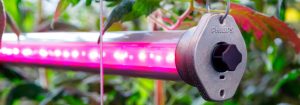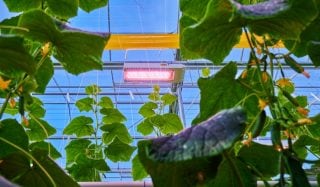Be the first! Get the latest news and updates - Subscribe to our newsletter!
Proven results of LED interlighting for high-wire cultivation?
Better light distribution over the crop
With a high-wire crop such as tomatoes, the light level decreases rapidly towards the bottom of the crop. Interlighting brings light to the spot in the crop where there is not enough light. This ensures that the lower leaves remain active and contribute to growth and production and you can also work with a higher plant density.

(Natural) Light level fades out in the canopy. LED interlighting compensates for it.
Lower leaves contribute more to photosynthesis
Photosynthesis measurements in the crop show the effectiveness of interlighting. With interlighting, the leaves appear to have a higher photosynthesis capacity halfway and at the bottom of the plant.

Lower leaves remain active and contribute to growth and production
More interlighting increases fruit weight
More LED interlighting - with the same climate - leads to a higher average fruit weight. Especially early in the lighting season. From April, when the influence of daylight increases, the influence of interlighting on the fruit weight decreases.

Fruit weight increases when adding more light early in the year
Earlier higher plant density for higher winter production.
When growing with LED interlighting, we have found through our research that going to a higher plant density earlier in the growing season, generates more fruits per m2 and therefor a higher winter production.

Conclusion
All in all the benefits of adding LED interlighting in a high-wire crop can be summarized by having more vital leaves and an improved photosynthesis, plus the amount of lit hours can be raised which leads to a higher average fruit weight. Second it is possible to go to a higher plant density earlier in the season and light the crop for more hours which will give you more fruits per m2
The combination with LED interlighting provides better control over climate and crop. This allows you to respond better to customer questions and you are more flexible in choosing a planting date. This leads to a consistent quality and higher yield at the right time.
LED interlighting contributes to stronger green parts of the plant. It gives a stronger and more vital crop with fruits of consistent quality. LED interlighting allows for higher light levels. The crops are lit from the right position, which leads to higher efficiency in light utilization.

Esther de Beer is Program Manager of Pre-development and Research at Philips Horticulture LED Solutions. She spends her days trying to make LED grow lights more effective. In this series of articles she explains the basics of how light works and how it affects plant growth.
Related articles
Contact us
Contact certified partners
Philips products are sold through a global network of certified partners. Find partners in your region for more information about Philips LED grow lights.
Contact Philips
What are the best LED grow lights for your situation? We are here to help. Please use our form to submit your request.
Subscribe to newsletter
Keep up to date about Philips LED lighting in horticulture by subscribing to our newsletter.
Join our team
Interested in discovering your recipe for growth and joining our team? Take a look at our career page for more information.
Interested?
Learn more about LED lighting in horticulture by reading our latest articles and case studies.



